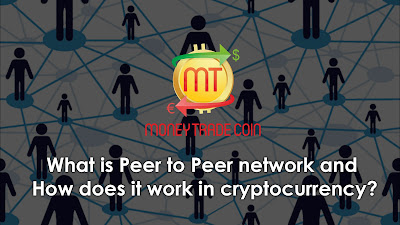Today’s cryptocurrency lesson is a little technical and thus a little complicated. It deals with the fundamental way in which cryptocurrencies like Bitcoin and Money Trade Coin are distributed, publicly validated and exchanged.
It’s called Peer to Peer networking, or P2P networking in short.
It’s a term you might have come across before. P2P file sharing networks were once extremely popular (and are still so, relatively speaking). By connecting to a network of users just like you across the world, you could share files with anyone and with the help of everyone. Unfortunately, this was largely used to pirate music and films, but it’s birth was in settings were large computation processes could have its workload shared among a large number of users, thereby making the workload of each individual user lighter.
It’s like working as a team for the benefit of everyone. But with one important distinction: you don’t need an intermediary.
Let’s take the example of file sharing again. You could just download it from a server dedicated towards the goal. But then that server would have to serve many hundreds of thousands of users, single-handedly handling the entire burden of distribution all by itself. Furthermore, the resource is only accessible to that server and not publicly available. Without it, the whole system stops functioning and the information in question is unavailable.
This general idea applies to cryptocurrency.
Satoshi Nakamoto, the yet-unknown creator of Bitcoin, used the blockchain technology to solve the double spending problem without a central authority to perform checks. We won’t go into those technical details here.
Now, Nakamoto used this idea of P2P networking - where all financial recordings and processing happened on equal terms with users on the network - to solve the problem of centralization. He, as he himself mentioned, design ‘A Peer-to-Peer electronic cash system’.
The P2P network is critical to solving that double spending problem we talked about before. In any economy, there must be a way to track that a certain amount of money has not been transacted twice. Traditionally, it is a central server that checks and records the balances of entities making transactions, ensuring that no entity repeats the same transaction.
With cryptocurrency, everyone on the blockchain network must agree for a transaction to take place, thus the burden of checking the balance is distributed among all users. An anomaly cannot occur because it would break the network. Every peer on the network has a record of all transactions that have taken place, and all balances, on the public ledger, thus making it impossible to fool the system.
And that’s how the decentralization problem was solved by Satoshi Nakamoto.
Hopefully, having read this, you’re a little more educated on cryptocurrency. We recommend reading up on this if it interests you. It helps to know about the intricacies of cryptocurrency and the important distinctions between individual currencies. Visit the Money Trade Coin blog to hear more of the fundamentals and interesting facts about the cryptocurrency world!
#MoneyTradeCoin #Newage #Cryptocurrency #MTCOIN
It’s called Peer to Peer networking, or P2P networking in short.
It’s a term you might have come across before. P2P file sharing networks were once extremely popular (and are still so, relatively speaking). By connecting to a network of users just like you across the world, you could share files with anyone and with the help of everyone. Unfortunately, this was largely used to pirate music and films, but it’s birth was in settings were large computation processes could have its workload shared among a large number of users, thereby making the workload of each individual user lighter.
It’s like working as a team for the benefit of everyone. But with one important distinction: you don’t need an intermediary.
Let’s take the example of file sharing again. You could just download it from a server dedicated towards the goal. But then that server would have to serve many hundreds of thousands of users, single-handedly handling the entire burden of distribution all by itself. Furthermore, the resource is only accessible to that server and not publicly available. Without it, the whole system stops functioning and the information in question is unavailable.
This general idea applies to cryptocurrency.
Satoshi Nakamoto, the yet-unknown creator of Bitcoin, used the blockchain technology to solve the double spending problem without a central authority to perform checks. We won’t go into those technical details here.
Now, Nakamoto used this idea of P2P networking - where all financial recordings and processing happened on equal terms with users on the network - to solve the problem of centralization. He, as he himself mentioned, design ‘A Peer-to-Peer electronic cash system’.
The P2P network is critical to solving that double spending problem we talked about before. In any economy, there must be a way to track that a certain amount of money has not been transacted twice. Traditionally, it is a central server that checks and records the balances of entities making transactions, ensuring that no entity repeats the same transaction.
With cryptocurrency, everyone on the blockchain network must agree for a transaction to take place, thus the burden of checking the balance is distributed among all users. An anomaly cannot occur because it would break the network. Every peer on the network has a record of all transactions that have taken place, and all balances, on the public ledger, thus making it impossible to fool the system.
And that’s how the decentralization problem was solved by Satoshi Nakamoto.
Hopefully, having read this, you’re a little more educated on cryptocurrency. We recommend reading up on this if it interests you. It helps to know about the intricacies of cryptocurrency and the important distinctions between individual currencies. Visit the Money Trade Coin blog to hear more of the fundamentals and interesting facts about the cryptocurrency world!
#MoneyTradeCoin #Newage #Cryptocurrency #MTCOIN




No comments:
Post a Comment